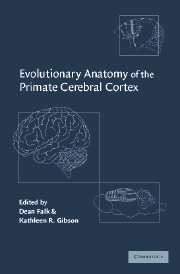Book contents
- Frontmatter
- Contents
- List of contributors
- Preface
- Prologue: Size matters and function counts
- Part I The evolution of brain size
- Part II Neurological substrates of species-specific adaptations
- Introduction to Part II
- 7 The discovery of cerebral diversity: an unwelcome scientific revolution
- 8 Pheromonal communication and socialization
- 9 Revisiting australopithecine visual striate cortex: newer data from chimpanzee and human brains suggest it could have been reduced during australopithecine times
- 10 Structural symmetries and asymmetries in human and chimpanzee brains
- 11 Language areas of the hominoid brain: a dynamic communicative shift on the upper east side planum
- 12 The promise and the peril in hominin brain evolution
- 13 Advances in the study of hominoid brain evolution: magnetic resonance imaging (MRI) and 3-D reconstruction
- 14 Exo-and endocranial morphometrics in mid-Pleistocene and modern humans
- Epilogue: The study of primate brain evolution: where do we go from here?
- Index
9 - Revisiting australopithecine visual striate cortex: newer data from chimpanzee and human brains suggest it could have been reduced during australopithecine times
Published online by Cambridge University Press: 07 October 2011
- Frontmatter
- Contents
- List of contributors
- Preface
- Prologue: Size matters and function counts
- Part I The evolution of brain size
- Part II Neurological substrates of species-specific adaptations
- Introduction to Part II
- 7 The discovery of cerebral diversity: an unwelcome scientific revolution
- 8 Pheromonal communication and socialization
- 9 Revisiting australopithecine visual striate cortex: newer data from chimpanzee and human brains suggest it could have been reduced during australopithecine times
- 10 Structural symmetries and asymmetries in human and chimpanzee brains
- 11 Language areas of the hominoid brain: a dynamic communicative shift on the upper east side planum
- 12 The promise and the peril in hominin brain evolution
- 13 Advances in the study of hominoid brain evolution: magnetic resonance imaging (MRI) and 3-D reconstruction
- 14 Exo-and endocranial morphometrics in mid-Pleistocene and modern humans
- Epilogue: The study of primate brain evolution: where do we go from here?
- Index
Summary
Although this author's (R.L.H.) disagreements with Harry Jerison are legion (e.g. Holloway, 1966,1974,1979), I have always found his ideas stimulating and thus of great value to my own work regarding human brain evolution. I believe we best honor Harry Jerison by taking his ideas seriously, whether or not we agree with them.
There do not appear to be any serious disagreements that the brain became reorganized as well as enlarged during hominid evolution, but there is considerable controversy as to when reorganization, particularly that relating to the reduction of primary visual striate cortex, Brodmann's area 17, had taken place. (Reviews of these questions can be found in Holloway, 1995, 1996.) Since the only way we will ever know for absolutely certain when this process occurred requires travel with a time machine and some histological sectioning of australopithecine brains, one might wonder why we are writing this paper. It is already apparent from the literature on early hominid brain evolution that a major controversy exists regarding the fossil australopithecine endocasts and their interpretation regarding that infamous landmark, the lunate sulcus. Falk (1983, 1985, 1986) interprets the paleoneurological evidence from the Taung and Hadar (AL162–28) endocasts as indicating that the lunate sulcus was in an anterior pongid-like position. Holloway (1981, 1983, 1984) interprets the evidence as suggesting a posterior, more modern-human like position.
- Type
- Chapter
- Information
- Evolutionary Anatomy of the Primate Cerebral Cortex , pp. 177 - 186Publisher: Cambridge University PressPrint publication year: 2001
- 11
- Cited by

